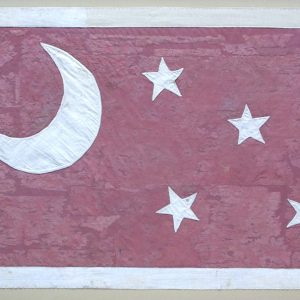calsfoundation@cals.org
Seventeenth Arkansas Infantry (CS)
The Seventeenth Arkansas was a unit that served in the Confederate army during the American Civil War. The unit saw service in Arkansas and in the Western Theater of the war. Another unit was also known as the Seventeenth Arkansas Infantry for a period.
The regiment organized on November 17, 1861, with eight companies from Washington, Sebastian, Madison, and Hempstead counties. The unit never gained two more companies to grow to full strength. Frank Rector was elected as the first colonel of the regiment.
Assigned to Brigadier General Benjamin McCulloch’s division in the Army of the West, the regiment served in a brigade under the command of Colonel Louis Herbert. The regiment’s first action came on February 18, 1862, at Bentonville (Benton County). The regiment and other Confederate units were defeated by a Federal force that captured the local courthouse. The regiment fought at the Battle of Pea Ridge in March 1862 and abandoned its colors during the engagement. Recovered by a Missouri artillery battery, the flag was returned to the regiment. The shame of the poor performance at this battle would continue to follow the unit for months.
Major General Earl Van Dorn ordered most Confederate forces in the state to move east of the Mississippi River after the battle. Part of four companies of the regiment remained in Arkansas after the transfer, along with Rector. These companies later formed part of the Thirty-Fifth Arkansas, also commanded by Rector. The companies that moved to the east bank of the Mississippi reorganized under Lieutenant Colonel John Griffith, who previously served as an inspector for the army. The unit was called the Seventeenth Arkansas Infantry (Griffith’s) to separate it from the original unit.
The regiment saw action at the Battle of Iuka on September 19, 1862, and won praise from its commanders for its performance. Losses in the battle totaled two killed, twelve wounded, and three missing from a strength of 109 men. Joining a brigade of Arkansas, Texas, Louisiana, Mississippi, and Missouri units under the command of Colonel W. Bruce Colbert, the regiment fought at the Battle of Corinth in October. During the battle, the regiment lost one man killed, thirteen wounded, and six missing.
In March 1863, the regiment consolidated with the Eleventh Arkansas Infantry. That regiment was captured at Island Number 10 in April 1862 and spent time in prison camps in Illinois and Ohio. The Eleventh was exchanged at Vicksburg on September 16, 1862. The new regiment was known as the Eleventh and Seventeenth Arkansas Infantry and was mounted. Colonel John Logan of the Eleventh Arkansas commanded the regiment. The unit was sometimes known as the Eleventh and Seventeenth Arkansas Cavalry due to the unit being mounted, and the name was also sometimes shortened to just the Eleventh Arkansas.
Serving in southern Mississippi and eastern Louisiana, the regiment saw action in the Port Hudson Campaign. Part of the regiment was captured when Port Hudson fell to Federal forces on July 9, 1863. Joining a cavalry brigade, the regiment served in southern and central Mississippi, seeing action near Clinton in October 1863. Logan commanded the brigade, and Griffith took command of the regiment. The brigade consisted of units from Mississippi, Louisiana, Tennessee, and the consolidated regiment of Arkansans.
On December 7, 1863, the regiment engaged a Union force near Natchez, Mississippi, pushing the enemy back into the fortifications surrounding the city. Logan returned to Arkansas during the winter of 1863, and Griffith took permanent command of the regiment. The unit served in a brigade under the command of Brigadier General Wirt Adams. The regiment fought in the Meridian Campaign in February 1864. In April 1864, it participated in the capture of the gunboat USS Petrel near Yazoo City.
The regiment continued to serve throughout Mississippi, fighting numerous skirmishes but few larger battles. The unit worked to keep Federal forces from extending their lines deeper into the state. The regiment ended the war in Mississippi and surrendered in Alabama in May 1865. Most of the members of the regiment were paroled on May 13. Two flags of the regiment survived the war. One is in the collection of the Old State House Museum in Little Rock (Pulaski County), and a company flag is in the collection of Wilson’s Creek National Battlefield in Missouri.
Another regiment also served as the Seventeenth Arkansas Infantry during the war. Organized in January 1862 in Yell County, the regiment consisted of eight companies from Conway, Johnson, Yell, and Prairie counties. George Lemoyne was elected colonel, and the unit joined Van Dorn’s movement to the east bank of the Mississippi River before it reached full strength. In Mississippi, the unit was first renamed the Seventeenth Arkansas Infantry Battalion before consolidating with the Fourteenth Arkansas to form a new unit known as the Twenty-First Arkansas. This regiment fought at Corinth and was captured at Vicksburg. Exchanged and returned to Arkansas, the regiment continued to serve in the Trans-Mississippi but saw little action for the remainder of the war.
For additional information:
Cozzens, Peter. The Darkest Days of the War: The Battles of Iuka and Corinth. Chapel Hill: University of North Carolina Press, 1997.
Hewitt, Lawrence. Port Hudson, Confederate Bastion on the Mississippi. Baton Rouge: Louisiana State University Press, 1987.
Mississippi in the Confederacy. Published by the Mississippi Department of Archives and History. Baton Rouge: Louisiana State University Press, 1961.
David Sesser
Henderson State University








Comments
No comments on this entry yet.